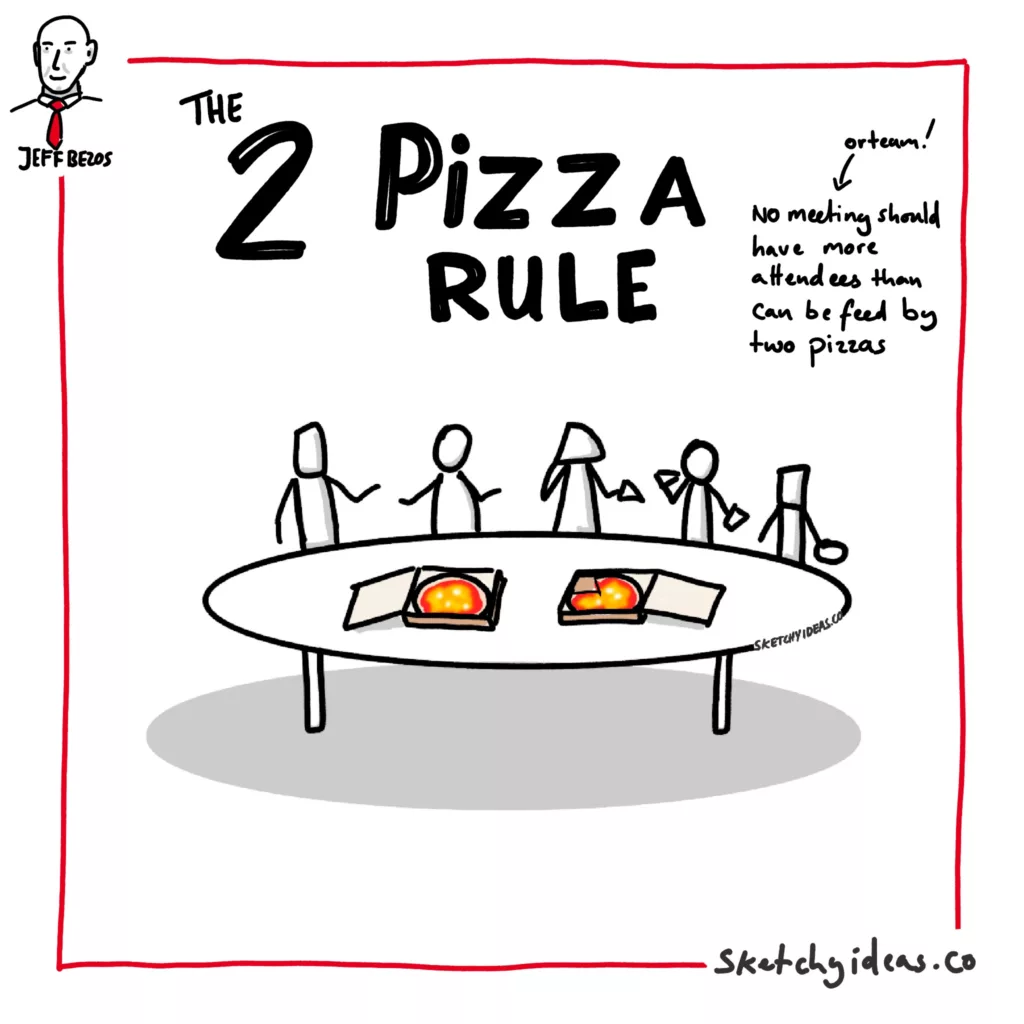When was the last time you were in a meeting you didn’t need to be at? Or perhaps you took a moment to look around the room and realised there were five people who had no need to be there. If you work in a corporation, there’s a good chance it was in the last week. The two pizza rule is a simple mental model from Jeff Bezos that he credited as a key to Amazon’s early success.
In this post we’ll look at what it is, why it works, and how to apply it.
What is the two pizza rule?
The 2 pizza rule states that you should be able to feed any meeting with just two pizzas. If you can’t, then you’ve got too many attendees.
In practice, this means about 6 to 10 people (depending on the size of your pizzas).

The goal of this rule is to avoid large meetings with attendees who shouldn’t be there and thus waste their time or risk bike shedding.
While this statement is primarily about meetings, Amazon applied this principle further. They also aimed to keep each team small and focused so that they could be more nimble.
Why does the two pizza rule matter?
There’s nothing magic about pizza (okay, it is an amazing food).
The secret of the rule is about keeping groups small, focused, and agile.
Plus, it does help decide what to get for a lunch meeting.
Small groups collaborate better
When you have a giant meeting, you invite the bystander effect.
If you aren’t the person leading, you sit back expecting someone else to make the point your thinking of. This is more true the less you know about the topic of a meeting.
It’s also harder to invite people to participate as you can’t let everyone speak.
By keeping meetings smaller, you get more people to collaborate and help make faster decisions — they can even help avoid design by committee.
Avoiding wasting time
Imagine a restaurant making three meals for everyone it served and throwing the other two away.
That’s what pointless meetings are like.
Salaries are often the largest cost for a company and adding excess members to a meeting ties up time that could be better spent elsewhere.
While meetings are necessary and even important, keeping meetings and teams lean helps avoid waste.
How to apply the 2 pizza rule
Yes, you can just set a rule to limit the number of people in a meeting (and that’s not bad). It’s better, however, to get to the goal behind the idea rather than just blindly implement a limit.
Your limit of 6 to 10 people will help you check the effectiveness of your goal.
But you can still keep the rule without applying the intention and end up wasting people’s times and making meetings less effective.
To make sure you do apply the idea behind the mental model.
- Set a clear agenda and objectives for each meeting — this will guide you as to whom you should invite.
- Invite selectively — use your objectives to guide whom to invite. Check if you need their expertise or input. If they only need to be informed of a decision, consider not inviting them but decimating information other ways.
- Set a time limit and use your agenda — this helps prevent bike shedding and focuses attention on the core needs.
- (Optional) Order pizza — You don’t have to order pizza, but if you’ve planned things right, it can be a treat to congratulate everyone on achieving the two pizza rule.
Example of the two pizza rule: Amazon
When Amazon was starting out, Jeff Bezos famously set the two pizza rule not just for meetings, but for all of Amazon’s teams.
He did so to help teams stay agile and focused. This trend has been attributed for their success and ability to deliver new products and innovations rapidly. While there have been some failures, like the Amazon fire phone, the success of others like AWS suggest that there’s merit in the approach.
Conclusion: Keep your meetings small to innovate faster
No one wants to waste anyone’s time, and yet meeting numbers can so easily end up ballooning — especially when office politics come into play!
But managing to apply the two pizza rule can help your company to innovate faster and deliver more rapid change. Plus, you instantly know how many pizzas to order for the next meeting.

Leave a Reply